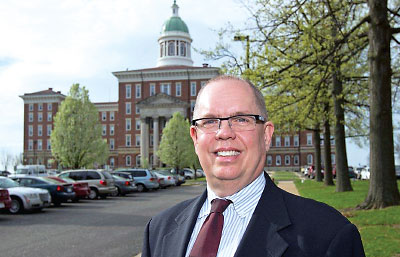Report Calls for Public Health Approach to Addressing Mass Violence
Abstract
Psychiatrists might try to incorporate questions relating to a patient’s risk for violence that are similar to questions about suicide risk.
Mass violence in the United States requires a broad-based public health approach and cooperation among multiple national and local systems and institutions, according to a report by the National Council on Behavioral Health (NCBH) titled “Mass Violence: Causes, Impacts, and Solutions.”
The 96-page report casts a wide net with recommendations for health care organizations; schools and community organizations; judicial, correctional, and law enforcement institutions; legislative bodies and government agencies; researchers; and the media.

Joseph Parks, M.D., medical director of the National Council on Behavioral Health, urges psychiatrists to have talking points ready when people in the community or media ask about the relationship between violence and mental illness.
“There isn’t a single cause to mass violence in America, and there isn’t going to be a single solution,” said Joseph Parks, M.D., medical director of the NCBH, at the IPS: The Mental Health Services Conference in New York in October. He was joined by John Rozel, M.D., an expert in threat assessment and president of the American Association for Emergency Psychiatry.
The report is the product of a 26-member expert panel including Jeffrey Lieberman, M.D., past APA president; and Debra Pinals, M.D., APA’s representative and chair of APA’s Council on Psychiatry and Law. In addition to Parks and Rozel, other psychiatrists and mental health professionals on the panel included Jacqueline Feldman, M.D., associate medical director of the National Alliance on Mental Illness; Jeffrey Swanson, Ph.D., associate director of the Division of Social and Community Psychiatry at Duke University; John Santopietro, M.D., physician-in-chief at Hartford HealthCare Behavioral Health Network; and William Pollack, Ph.D., an associate professor of psychiatry at Harvard Medical College. APA was pleased to be a part of the report; however, some of the recommendations do not reflect current APA policy.
(Although the report addresses mass violence wherever it may occur, at the IPS meeting, Parks and Rozel highlighted findings and recommendations regarding school violence. See story).
A crucial point in the report is that serious mental illness does not play a significant role in mass violence.
“While mental illness is too often used as the default explanation for these tragic events, statistics indicate that the rates of mental illness among those who commit mass violence are comparable to those of the general public,” Parks said.
People with serious mental illness (such as schizophrenia and bipolar disorder) are responsible for less than 4% of all violence and a quarter to a third of mass violence, Parks said. However, mental distress—associated with isolation, a history of trauma or violence, feelings of injustice and substance use—is strongly associated with violence.
Regarding prevention, the council calls for the kind of multifaceted public health approach that is employed for other public health problems. This approach includes universal, selective, and indicated prevention measures.
Universal: A public education campaign to help identify “people of concern.”
Selective: Measures to assess and intervene with people with specific identified warning signs and access to weapons capable of inflicting mass casualties but no history of past significant violence, communication of threat, or evidence of planning.”
Indicated: Measures to contain, assess, and intervene with people with a history of threatened or actual significant violence, specific warning signs that include communications of threat, evidence of planning/practice, and access to weapons capable of inflicting mass casualties.
In comments to Psychiatric News, Parks said individual psychiatrists and mental health professionals should try to include a violence risk assessment in their evaluations of patients, including questions about gun ownership and storage of firearms.
“Psychiatrists might try to work into their interviews questions about lethal means reduction—where do patients store their guns and what are they going to do if they become symptomatic [in a way that puts them at risk for becoming violent],?” Parks said. “I think many of us are better and more comfortable at interviewing patients about suicide risk, but many of the same principles apply when inquiring about risk for violence: What would have to happen between now and the next time I see you to cause you to become violent?”
The report notes that mental health advance directives, including “Ulysses contracts,” can aid in preventing mass violence during times of exacerbation of mental illness. In a Ulysses contract, patients document their agreement to have their guns temporarily removed when a clinician decides their risk of using them to harm themselves or others has become significant. The psychiatric advance directive, which offers instruction for mental health treatment and authorizes a health care proxy, might be especially important for young adults transitioning into college, a time when mental illnesses often are exacerbated, according to the report.
The report especially emphasizes the value of community “threat assessment teams” in containing, assessing, and intervening with young people who have a history of threatened or actual violence along with the warning signs. These multidisciplinary teams might include mental health, security, human resources, legal, and law enforcement representatives.
Among the report’s specific sets of recommendations are those for health care organizations and for researchers. The recommendations for researchers emphasize that current models of research on violence and mental illness are not able to reliably predict violence at the individual level. The recommendations call for the creation of a mandatory, standardized investigation and analysis of each mass violence incident, conducted by a multiagency team led by the Department of Justice.
According to the report, “Simplistic conclusions [about the relationship between mental illness and violence] ignore the fact that mass violence is caused by many social and psychological factors that interact in complex ways; that many, if not most, perpetrators do not have a major psychiatric disorder; and that the large majority of people with diagnosable mental illnesses are not violent toward others.” ■
“Mass Violence in America: Causes, Impacts, and Solutions” is posted here.



